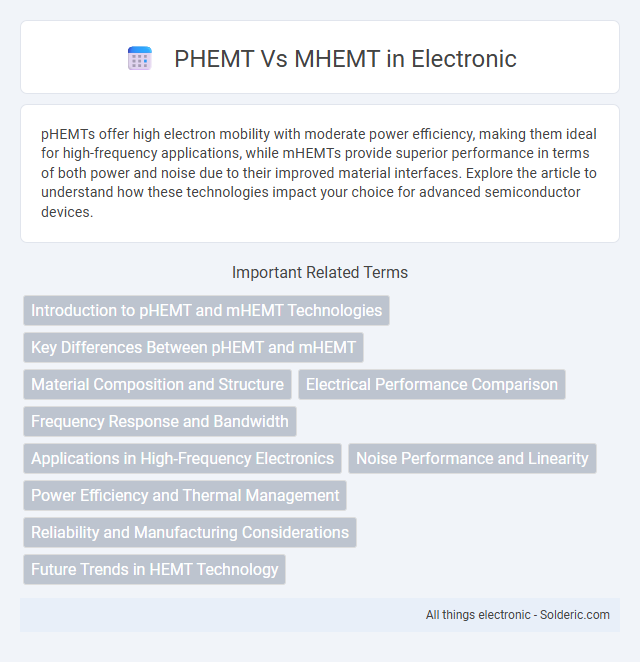pHEMTs offer high electron mobility with moderate power efficiency, making them ideal for high-frequency applications, while mHEMTs provide superior performance in terms of both power and noise due to their improved material interfaces. Explore the article to understand how these technologies impact your choice for advanced semiconductor devices.
Comparison Table
| Feature | pHEMT (Pseudomorphic HEMT) | mHEMT (Metamorphic HEMT) |
|---|---|---|
| Material Structure | Pseudomorphic layer on GaAs substrate | Metamorphic buffer on GaAs or Si substrate |
| Electron Mobility | High electron mobility (~1500-2500 cm2/Vs) | Higher electron mobility (up to ~3000 cm2/Vs) |
| Operating Frequency | Up to 100 GHz | Exceeds 100 GHz, suitable for mmWave |
| Material Compatibility | Limited to lattice matched materials | Flexible lattice mismatch handling |
| Applications | Microwave communications, low-noise amplifiers | High-frequency radar, 5G, satellite communications |
| Cost | Lower cost due to established processes | Higher cost due to complex buffer layers |
Introduction to pHEMT and mHEMT Technologies
Pseudomorphic High Electron Mobility Transistors (pHEMTs) utilize a strained InGaAs channel layer on GaAs substrates, enabling higher electron mobility and superior frequency response compared to traditional HEMTs. Metamorphic High Electron Mobility Transistors (mHEMTs) employ a metamorphic buffer layer to integrate InGaAs channels on GaAs or Si substrates, allowing for enhanced performance at millimeter-wave frequencies and improved integration with silicon-based technologies. Both pHEMT and mHEMT structures leverage heterojunction engineering to optimize electron transport and device speed for advanced RF and microwave applications.
Key Differences Between pHEMT and mHEMT
pHEMT (pseudomorphic High Electron Mobility Transistor) features a strained heterojunction layer that enhances electron mobility by reducing defects, while mHEMT (metamorphic High Electron Mobility Transistor) employs a lattice-mismatched buffer layer enabling integration with various substrates. Your choice between pHEMT and mHEMT depends on factors like operating frequency, substrate compatibility, and power efficiency, with pHEMT excelling in low-noise applications and mHEMT suited for higher power and wider bandwidth. The key differences lie in material structure, substrate flexibility, and performance optimization, making each suitable for distinct high-frequency electronic applications.
Material Composition and Structure
pHEMT devices typically utilize a heterojunction formed between gallium arsenide (GaAs) and aluminum gallium arsenide (AlGaAs), leveraging a pseudomorphic strained layer to enhance electron mobility and reduce scattering. In contrast, mHEMTs employ an indium gallium arsenide (InGaAs) channel grown on an indium phosphide (InP) substrate, resulting in a metamorphic buffer layer that accommodates lattice mismatch and enables higher-speed operation. Your choice between pHEMT and mHEMT will depend on the desired electron mobility, frequency performance, and compatibility with existing semiconductor processes.
Electrical Performance Comparison
pHEMTs offer high electron mobility and low noise figures, ideal for microwave and RF applications, while mHEMTs provide enhanced electron velocity and improved cutoff frequency, resulting in superior high-frequency performance. Your choice depends on application-specific electrical requirements such as gain, power efficiency, and noise performance. mHEMT technology generally delivers better linearity and higher output power, making it more suitable for advanced communication systems.
Frequency Response and Bandwidth
pHEMTs (pseudomorphic High Electron Mobility Transistors) offer high frequency response with operational ranges typically up to 100 GHz, while mHEMTs (Metamorphic HEMTs) push this boundary further into the millimeter-wave spectrum, often exceeding 200 GHz. mHEMTs provide improved bandwidth due to their ability to integrate lattice-mismatched substrates, enhancing electron mobility and reducing noise figure. The superior frequency response and broader bandwidth of mHEMTs make them ideal for advanced high-speed communication and radar applications.
Applications in High-Frequency Electronics
pHEMTs (pseudomorphic high electron mobility transistors) offer superior electron mobility and higher frequency operation, making them ideal for low-noise amplifiers and high-speed communication systems. mHEMTs (metamorphic high electron mobility transistors) enable operation at even higher frequencies and power levels, suitable for millimeter-wave applications such as 5G networks and radar systems. Your choice between pHEMT and mHEMT depends on requirements for bandwidth, noise performance, and power efficiency in advanced RF and microwave devices.
Noise Performance and Linearity
pHEMTs exhibit superior noise performance due to their high electron mobility and low gate leakage, making them ideal for low-noise amplifiers in RF applications. mHEMTs generally offer enhanced linearity resulting from their materials and device structure, which better handle high power signals with reduced distortion. Comparing both, pHEMTs excel in minimizing noise figure while mHEMTs provide improved linearity for demanding communication system requirements.
Power Efficiency and Thermal Management
pHEMTs exhibit higher power efficiency due to their superior electron mobility and lower noise figure, making them ideal for high-frequency applications with moderate thermal constraints. mHEMTs, leveraging metamorphic buffer layers, enable operation at higher power densities and improved thermal conductivity, enhancing thermal management in demanding environments. This results in better heat dissipation and reliability for mHEMTs under high-power and high-temperature conditions compared to pHEMTs.
Reliability and Manufacturing Considerations
pHEMT devices offer proven reliability with mature fabrication processes, making them suitable for high-volume production with consistent yields. mHEMT technology, while delivering superior performance at higher frequencies, involves more complex manufacturing steps that can lead to increased variability and potential reliability challenges. Choosing between pHEMT and mHEMT depends on your specific application needs, balancing performance requirements against manufacturing complexity and long-term device stability.
Future Trends in HEMT Technology
Future trends in HEMT technology emphasize the advancement of mHEMTs due to their superior electron mobility and enhanced thermal stability compared to pHEMTs, making them ideal for high-frequency and high-power applications. Innovations in material systems, such as incorporating GaN and InP substrates, are driving performance improvements in mHEMT devices for 5G and satellite communications. Research continues to optimize gate design and scaling techniques in mHEMTs to achieve lower noise figures and higher linearity, essential for next-generation wireless infrastructure.
pHEMT vs mHEMT Infographic

 solderic.com
solderic.com